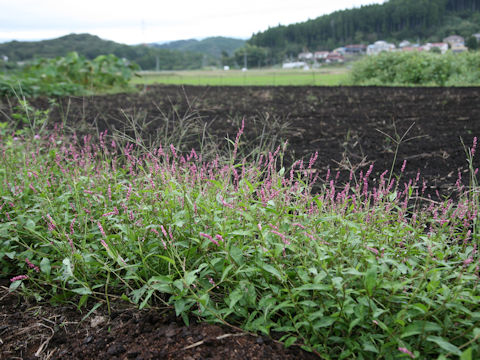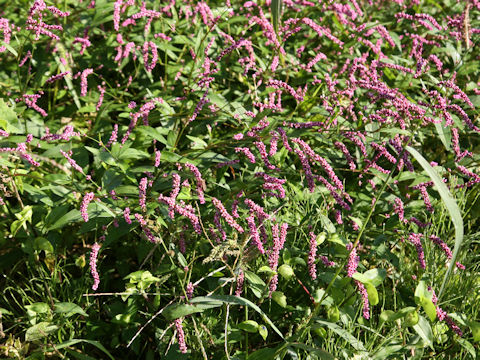
|
|
|
|
−− もっと見る(Show more)−−
−− 閉じる(Close) −−
|
|
|
|
わが国の各地をはじめ、朝鮮半島や中国に分布しています。どこにでもよくある雑草です。道端や畑、荒れ地などに生え、高さは30〜40センチになります。花期は6月から10月ごろ。昔は「あかまんま」と呼んで、ままごとにも使いました。本物ではないとか質が劣るもの、役に立たないものに「イヌ」をという言葉をつけるようです。「おおいぬたで(大犬蓼)」より小さくて、花穂が短くて垂れません。中国名では「長鬃蓼(chang zong liao)」と呼ばれます。 |
|
|
タデ科イヌタデ属の一年草で、学名は Persicaria longiseta。英名はありません。 |
|
|
The "Inu-tade" (Persicaria longiseta) belongs to Polygonaceae (the Knotweed family). It is an annual herb that is native to Japan, the Korean Peninsula and China. It is a weed which can be found anywhere. This herb grows in roadsides, fields or waste lands and can reach 30-40 cm in height. Its flower season is June through October. It is smaller than the Curlytop knotweed (Persicaria lapathifolia) and its flowering spikes are short and not drooping. In the old days, we called them "akamanma" and used them for playing house. It seems that the word "inu" is attached to things that are not real, of inferior quality, or useless. Its Chinese name is "長鬃蓼" (chang zong liao). |
|
|
[上・中1・中3] 大阪府交野市「大阪市大付属植物園」にて、2007年11月10日撮影。 [中2] 大阪府四條畷市下田原にて、2004年10月11日撮影。 [中4・中5] 山形県小国町小玉川にて、2015年09月18日撮影。(photo by Aya Seko) [中6〜中8] 同上にて、2017年09月10日撮影。 [中9〜中11] 同上にて、2018年09月19日撮影。 [中12〜中14] 宮城県川崎町支倉にて、2020年10月20日撮影。 [中15〜中17] 同上にて、2022年09月20日撮影。 [中18・中19] 同上にて、2023年09月30日撮影。 [中20〜21・下] 宮城県村田町沼田にて、2024年10月12日撮影。 |

|
|
Shu Suehiro |






















